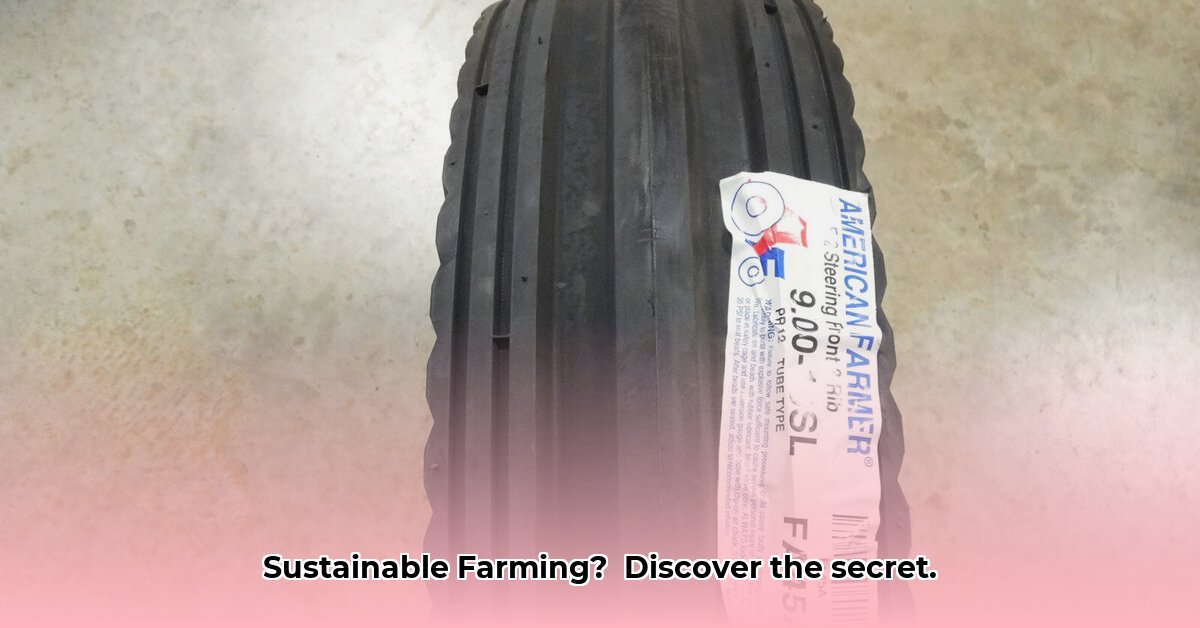
Understanding 9.00-10 Tractor Tires: A Sustainability Perspective
The ubiquitous 9.00-10 tractor tire, a workhorse on countless farms, presents a compelling case study in sustainable agriculture. While these tires are essential for various agricultural tasks, their environmental impact remains largely unexplored. This article examines the sustainability challenges surrounding 9.00-10 tires, providing actionable intelligence for key stakeholders to promote environmentally responsible practices. Aren't improved sustainability practices in agriculture worth the effort? For more information on tire sizes, check out this helpful size chart.
Market Overview: Size, Capacity, and the "FI" Designation
9.00-10 tires are characterized by their compact size, typically supporting loads around 2050 pounds at 56 psi. The common "FI" designation signifies their suitability for both fieldwork and limited highway use, offering farmers versatility. However, this dual-purpose design may influence tire longevity and, consequently, its overall environmental footprint. This highlights a key trade-off between operational convenience and long-term sustainability. How can we balance these competing needs effectively?
Sustainability Considerations: Data Gaps and Lifecycle Impacts
A critical gap exists in our understanding of the complete lifecycle environmental impact of 9.00-10 tires. Comprehensive data on material sourcing, manufacturing processes, and end-of-life management is lacking. This makes it difficult to accurately quantify their overall sustainability. This lack of information hinders informed decision-making across the agricultural sector. What steps can be taken to address this critical data deficit?
Risk Assessment Matrix: Identifying Key Challenges
| Risk Factor | Likelihood | Impact | Mitigation Strategy |
|---|---|---|---|
| Tire Failure | Medium | High | Regular inspections, proper inflation, timely replacement |
| Unsustainable Materials | High | Medium | Transition to sustainable materials, improved sourcing |
| Poor Recycling Infrastructure | High | Medium | Invest in recycling, develop clear disposal guidelines |
| Lack of Standardized Metrics | High | Medium | Develop industry standards for sustainability assessment |
The absence of standardized metrics for assessing tire sustainability further complicates the issue. This lack of consistent evaluation criteria makes it difficult to compare different tire brands or designs.
Actionable Intelligence: A Roadmap for Sustainable Practices
Addressing the sustainability challenges requires a multi-stakeholder approach. The following actionable steps are crucial for driving positive change:
1. Tire Manufacturers: Driving Innovation in Sustainable Tire Production
- Conduct Full Lifecycle Assessments (LCAs): Thoroughly evaluate the environmental impact of your tires, from raw material extraction to disposal, including energy consumption and waste generation at every stage.
- Prioritize Sustainable Materials: Explore and implement the use of bio-based rubber, recycled rubber content, and other innovative, environmentally friendly materials.
- Invest in Tire Recycling Infrastructure: Develop and support efficient recycling processes and technologies for 9.00-10 tires, maximizing the reuse of materials and minimizing waste.
2. Farmers and Agricultural Businesses: Adopting Sustainable Practices
- Maximize Tire Lifespan: Prioritize purchasing durable tires designed for extended service life. This reduces the number of tire replacements needed, minimizing waste and resource consumption.
- Maintain Proper Tire Inflation: Regularly monitor and adjust tire pressure to optimal levels. This extends tire life, improves fuel efficiency, and reduces the release of wear particles.
- Advocate for Sustainable Practices: Actively support policies and initiatives that promote the development and adoption of sustainable tire materials and disposal methods.
3. Researchers and Universities: Filling the Knowledge Gap
- Conduct Comprehensive Lifecycle Studies: Conduct research to quantify the environmental impact of tire manufacturing, use, and disposal across different materials and designs (including microplastic release, chemical leaching, and soil contamination).
- Develop Standardized Metrics: Create consistent and reliable metrics for evaluating the environmental performance of 9.00-10 tires. This will facilitate meaningful comparisons and drive innovation.
- Explore Innovative Recycling Technologies: Invest in research and development of advanced recycling techniques to recover and reuse materials from end-of-life tires.
4. Government Agencies: Shaping Policy for Sustainable Agriculture
- Fund Research and Development: Allocate resources to support research focused on sustainable tire materials, manufacturing processes, and recycling technologies.
- Implement Environmentally Conscious Regulations: Develop and enforce regulations that incentivize the use of sustainable tires and promote environmentally responsible tire disposal practices (e.g., extended producer responsibility schemes).
Conclusion: Towards a Greener Future for Farming
The sustainability of 9.00-10 tractor tires hinges on a collaborative effort among all stakeholders. By addressing the identified data gaps, implementing the recommended actions, and promoting innovation, we can significantly reduce the environmental impact of these essential agricultural tools. This collective commitment will pave the way for a more sustainable and environmentally responsible future for agriculture. The potential for innovation in sustainable tire materials and recycling is significant. Let's seize this opportunity to make a difference.